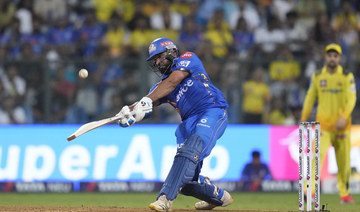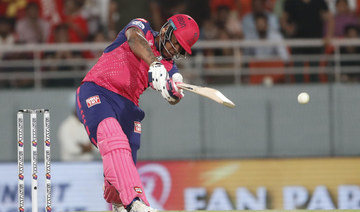MUMBAI: Seconds after the NBA’s first games in India ended, the packed Mumbai stadium erupted with cheers as spectators — some of whom were still struggling to understand basketball etiquette — rose to their feet.
In a country where cricket reigns supreme, basketball has long struggled to make a mark, and the NBA took no chances, launching a promotional blitzkrieg before the pre-season games between the Sacramento Kings and the Indiana Pacers.
As Indiana Pacers power forward Myles Turner, who helped his team to victories on Friday and Saturday, put it: “When you think of basketball, you don’t necessarily think of India.”
But the 7,000 sold-out seats and howls of enthusiasm at Saturday’s match suggested that, at least for some Indians, basketball matters.
“It was an exhilarating experience ... a brilliant experience,” said 22-year-old graduate student Akash Saraswati, who saved up for his ticket costing more than $90.
Even a broken leg could not stop him traveling to Mumbai from the neighboring city of Pune. “I didn’t hesitate,” he said.
Many of those who packed the stands were die-hard fans like Saraswati, traveling from as far afield as Delhi and Bangalore.
Others were there for a taste of something new, grappling with the rules as they watched the players dribble, dive and dunk.
“There’s so much grace and effortless co-ordination among the players. It’s beautiful to watch,” said sales executive Rajesh Kamble, who admitted he was still trying to figure out the sport.
The game may have confused some, but the entertainment was familiar territory — Bollywood dances replaced cheerleader routines and a Mumbai hip-hop group took over the floor before the tip-off.
The courtside audience included celebrities such as Bollywood superstar Priyanka Chopra-Jonas. The biggest ovation of the night however was for NBA legend Larry Bird, whose presence brought the crowd to its feet.
But questions remain about how much the NBA — whose 2017-18 season revenue was a staggering $8 billion, according to Forbes — is willing to invest in India and whether its audience will be restricted to hardcore fans and wealthy urbanites.
“The fact that the circus has come to town is a great thing,” said Vishal Jhunjhunwala, partner at Mumbai-based sports marketing firm, Square Consulting.
“But what happens once the circus leaves town?
“You need a local connect, a superstar with Indian roots for basketball to take off. That doesn’t exist at the moment, unlike say China where the presence of a star like Yao Ming galvanized his whole country into following the sport,” Jhunjhunwala said.
No Indian player has ever taken part in an NBA game and although NBA Commissioner Adam Silver told reporters that he hopes to see that change within five years, few are holding their breath.
And, unlike cricket which is played everywhere from India’s slums to members’ clubs, basketball enjoys a limited appeal in the country of 1.3 billion people.
The cheapest ticket for Saturday’s game cost 4,500 rupees ($65), going up to an astronomical 85,000 rupees for courtside seats. In comparison, a season pass for next week’s second Test between India and South Africa in Pune tops out at 5,000 rupees.
Although the high price did not deter well-heeled sports fans, analysts say the NBA risks losing out on a huge chunk of India’s audience if it doesn’t build up mass appeal.
“You are asking people to spend a lot to watch a sport they don’t know much about,” said Jhunjhunwala.
To those in the stands, however, the spectacle was well worth the big bucks.
“I am a cricket fan but... basketball also has huge potential and hopefully this is the start of a new sporting journey,” said 25-year-old Danish Contractor.
In his comments, the NBA’s Silver said the games “required us bringing in a court, a scoreboard, seats, locker rooms” to Mumbai.
They will have to do much more if the sport is to have a long-term future in the country, experts say as the NBA pre-season Asia tour now heads off to Japan and China for further matches over the coming week.
“One game isn’t going to turn India into a basketball-loving nation. But it’s a first step,” said Jhunjhunwala.
“If they lose money on it, well, they have deep pockets.”
NBA scores on debut in cricket-mad India but questions remain
NBA scores on debut in cricket-mad India but questions remain

- In a country where cricket reigns supreme, basketball has long struggled to make a mark in India
- Basketball enjoys a limited appeal in the country of 1.3 billion people
Mumbai Indians survive Ashutosh Sharma scare to beat Punjab Kings
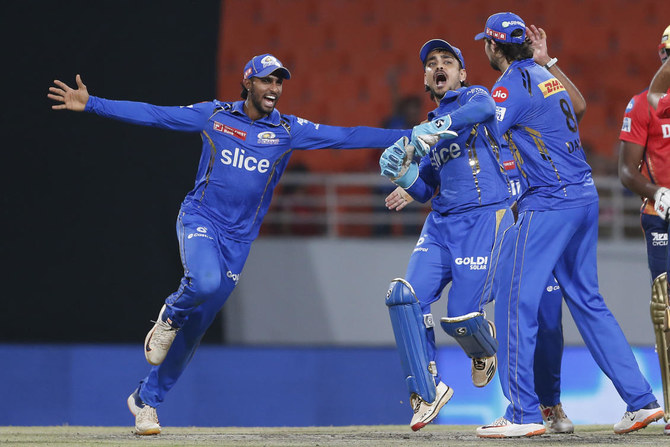
- Suryakumar Yadav hit an impressive 78 runs off 53 balls to help Mumbai Indians post a solid 192-7
- Sharma hit an explosive 61 runs off 28 balls for the Punjab Kings, but it was not enough to carry the day
MULLANPUR, India: Mumbai Indians managed to fend off a valiant effort by Punjab Kings batsman Ashutosh Sharma to win by nine runs in a fiercely fought IPL thriller on Thursday.
Invited to bat first, Mumbai Indians started off on a decent note. After losing only two wickets in the first 12 overs, Suryakumar Yadav went on to smash an impressive 78 runs off 53 balls to help the team post a solid 192-7.
The second innings began on a disastrous note for the Punjab Kings, with fast bowler Gerald Coetzee and Indian pacer Japsrit Bumrah striking quick to leave them reeling at 14-3 at the end of the second over.
Sharma eventually managed to help rebuild the innings with an explosive 61 runs off 28 balls, aided ably by Shashank Singh (41) and Harpreet Brar (21), but it was ultimately not enough to carry them through the day.
Punjab Kings acting captain Sam Curran said it was “heart-breaking” for his team to take it close and still lose.
“This team loves a close game. Got well to get close, thanks to Ashutosh... Hopefully we can win the close ones and get the momentum,” Curran added.
Mumbai openers Ishan Kishan and Rohit Sharma kicked off the first innings with an 18 run partnership before Kishan, who hit eight runs off eight balls, fell in the third over leaving the team at 18-1.
Sharma, who scored a 25-ball 36, built another partnership with Suryakumar Yadav before falling in the 12th over. Yadav went on to smash 78 runs off 53 balls before being dismissed in the 17th over.
Young Tilak Varma went on to rack up a solid 18-ball 34, with the assistance of cameos from Hardik Pandya (10) and Tim David (14), to help Mumbai wrap up the first innings at 192-7.
The game seemed in the bag in the early portion of the second innings, partly due to sharp bowling by Coetzee and Bumrah, who took three wickets each.
When the glimmer of hope given by Sharma was extinguished, Kagiso Rabada put up a last-ditch attempt with eight runs off three balls but ultimately ended up falling in the last over.
“What a game. We started really well. Cricket’s a funny game. We thought we had it, they battled really well. Then it was like a see-saw,” said Coetzee.
Li and Hend one back of Catlin while Moroccans Lguirati and Raouzi make cut at 2024 Saudi Open

- John Catlin birdied the 18th to remain at the top of the 2024 Saudi Open presented by PIF leaderboard
- Moroccans Ayoub Lgiurati and Othman Raouzi made the cut as Saudi amateur Khalid Walid Attieh missed by one stroke
RIYADH: Li Haotong and Scott Hend made the most of the calm morning conditions to head into the weekend one shot behind pacesetter John Catlin, who leads on 10-under-par after day two of the 2024 Saudi Open presented by PIF.
Catlin birdied the 18th hole as the sun set on a warm day at Riyadh Golf Club to ensure he heads into Friday ahead of Chinese star and DP World Tour member Li, who shot a scintillating 65, and Australian Hend. Steve Lewton’s 64 was the best round of the day and sees him in third place alongside David Puig, who finished his round with a triple bogey on the ninth hole.
Amateur Khalid Walid Attieh looked set to make history as the first Saudi player to make the cut since the tournament was elevated to the Asian Tour, however three bogeys on the back nine saw him miss out by one, with a putt just sliding by at the last.
Moroccan golfers Ayoub Lguirati and Othman Raouzi, who were two of the golfers given special invites to the tournament as part of Golf Saudi’s strategic partnership with the Arab Golf Federation, finished on one-under-par and even par respectively to extend their participation.
Lguirati said: “It was a positive day for me with only one bogey and one birdie. I stuck to my strategy all day and ended with a good result in a tough competition. I am very happy to have made the cut in this tournament and to play over the next two days.
“I usually play on the second tier Asian Development Tour but with the help of the Royal Moroccan Golf Association and Golf Saudi I have been able to reach this level and I continue improving.”
Meanwhile, Li is excited to challenge for the 2024 Saudi Open presented by PIF trophy as he looks to put some recent poor form behind him. Four birdies in five holes on his back nine catapulted him up the leaderboard.
Li said: “I played really well and wasted some chances. The course played a lot easier compared to yesterday, because of no wind and easier pin positions.
“I am still struggling a little bit off the tee, but except for that everything’s pretty solid overall. I am here to try and get the job done and get the trophy! So hopefully I have a hot start tomorrow.”
Li will play alongside Hend and Catlin on Friday, but will be wary of Asian Tour Order of Merit leader Puig in the penultimate group, who won the PIF Moment of the Day for a stunning front nine of 29, which included five birdies and an eagle in his first six holes.
Rain wipes out first Pakistan-New Zealand T20 after just two balls
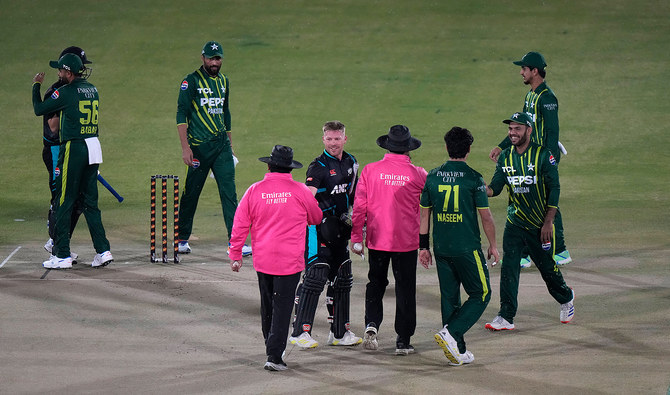
- Fast bowler Mohammad Amir returned to international cricket after nearly four years
- Having come out of retirement last month, Amir’s participation was limited to just fielding
RAWALPINDI: Heavy rain caused the first Twenty20 international between Pakistan and New Zealand to be abandoned after just two deliveries in Rawalpindi on Thursday.
New Zealand skipper Michael Bracewell won the toss, which had also been delayed by 30 minutes, and opted to bat but no action was possible for two-and-a-half hours.
Umpires Ahsan Raza and Aleem Dar then announced a five-over-a-side game at 10:10 local time (9:10 GMT).
Pakistan paceman Shaheen Shah Afridi conceded two leg-byes to debutant Tim Robinson off the first ball before bowling the batsman with a sharp delivery off the next.
But as soon as the Pakistan fielders started celebrating the wicket, the rain returned to force an abandonment.
Fast bowler Mohammad Amir returned to international cricket after nearly four years, having come out of retirement last month, but his participation was limited to just fielding.
The 32-year-old retired in December 2020 after being dropped from the side but changed his mind last month and decided to restart his career, which had already been stalled by a match-fixing ban in 2010.
Pakistan handed T20I caps to batsman Usman Khan, spinner Abrar Ahmed and all-rounder Muhammad Irfan Khan, while Robinson debuted for New Zealand.
The remaining matches are in Rawalpindi on April 20 and 21 and in Lahore on April 25 and 27.
The series gives a chance to both teams to test their bench strength ahead of the Twenty20 World Cup to be held in June in the United States and the West Indies.
New Zealand are without nine key players, including skipper Kane Williamson, who are playing in the ongoing Indian Premier League.
Juventus ordered to pay Ronaldo $10.4 million in back salary

- The five-time Ballon d’Or winner was the world’s highest-paid sportsman in 2023, with $136 million, including $46 million in wages
Rome: Juventus must pay Portuguese star Cristiano Ronaldo 9.7 million euros ($10.4 million) in back wages for the 2020-21 season, the Italian courts announced on Wednesday.
The Court of Arbitration, to which Ronaldo appealed, “orders Juventus Turin to pay the sum of 9,774,166.66 euros,” plus interest and procedural costs, it stated in its decision.
The sum equates to the difference between the salary actually received by Ronaldo and that which he should have received after tax and other deductions.
Ronaldo, who spent three seasons in Italy with Juventus (2018-21) before joining Manchester United (2021-22) and then the Saudi club Al Nassr, was claiming 19.5 million euros but the arbitration panel reduced that by 50 percent.
Contacted by AFP, Juventus declined to comment, but said it would be issuing a statement “shortly.”
According to the rankings drawn up by the American business magazine Forbes, the five-time Ballon d’Or winner was the world’s highest-paid sportsman in 2023, with $136 million, including $46 million in wages.
Juventus, who are listed on the stock exchange, recorded losses of 123.7 million euros in the 2022-23 financial year, which ran to the end of June, it announced in October.
No provision has been made in the accounts of Italian football’s most successful club, currently third in Serie A, for the payment of this wages backlog.
Marketing as much behind expansion of Asia Cup as merit
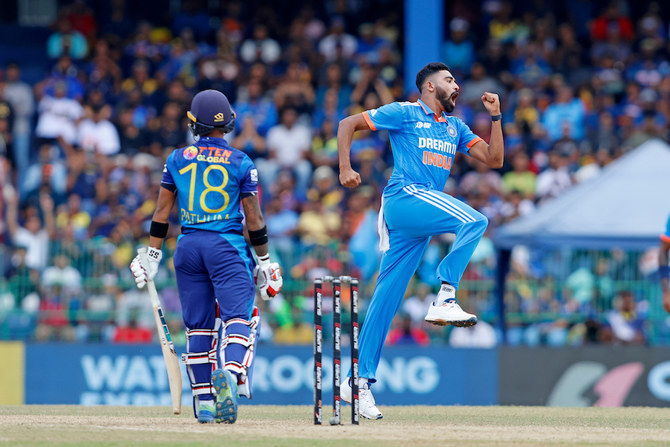
- Non-cricket fans may struggle to comprehend the links between the Asia Challenger Cup, the Asia Premier League and the Asia Cup
MUSCAT: Even to cricket aficionados — sometimes referred to as badgers — the various ways teams can qualify for the world’s major tournaments might appear opaque.
As may the term “badger”. Badgers are known for their tenacity, focus and persistence, qualities which can apply to those who dedicate chunks of their life to the game, its history, statistics, spectating, discussion and administration. This is not a complete list, but it provides a flavor.
A test case for tournament opaqueness is the Asia Cup. Non-badgers can be forgiven if they fail to comprehend the links between the Asia Challenger Cup, the Asia Premier League and the Asia Cup. They all fall under the aegis of the Asia Cricket Council and their existence represents an attempt by the organization to provide a more coherent regime for qualification into the big event — without using the word “qualification.”
The situation was much simpler in 1983, when the ACC was founded with the aim of promoting goodwill between Asian countries. In 1984, the first edition of the Asia Cup was held in Sharjah, where the ACC was based. It was One Day International in format and India won, but then boycotted the 1986 event because of strained relations with Sri Lanka. Strained political relations with India caused Pakistan to boycott it in 1991 event, whilst the 1993 cup was cancelled for the same reasons. Sadly, the ACC’s original aim was sorely tested almost from the outset.
Subsequent tournaments did not fit any regular temporal pattern. It was not until 2009 that the tournament was regularized onto a biennial basis. In 2015, the ACC announced the tournament would be played on rotation between ODI and Twenty20 International formats. Despite the introduction of a group stage to allow a slight expansion in the number of teams, the tournament has normally had only six competitors.
The International Cricket Council’s decision in April 2018 to grant T20I status to all 104 member nations – both men’s and women’s teams - has had far-reaching effects on cricket, including the Asia Cup. The number of countries with teams playing formalized T20 cricket at international level has grown rapidly.
It could be argued that the decision democratized cricket for both men and women. The 50-over ODI format requires a longer commitment and a deeper allocation of resources beyond the means of many of the boards administering cricket. T20 cricket offered a quicker, less resource-intensive route for the teams of associate member countries to test themselves not only amongst their peers, but also against the full members on the pitch. It has become a format for the many, not the few.
However, there remains a huge gulf between funds available to associate members and full members. This situation is exacerbated by the ICC’s decision-making regime which allows very little representation for associates. In the latest, 161st edition of the Wisden Almanack, its editor berates last year’s decision to increase the Board of Control for Cricket in India’s share of ICC’s central funds from 25 to 38.5 percent. It is not as if it needs the funds.
The BCCI argues that, since it brings the lion’s share of revenue into the game, it should be proportionately rewarded. This argument suggests a desire to control other members rather than encourage their development. Wisden’s editor asks: “Is it really beyond the wit of the administrators to distribute cash according to need, not greed?” By way of example, the West Indies cricket board receives just under 5 percent of ICC central funds. No wonder its premier players frequent the game’s franchise leagues.
The views of Wisden’s editor will probably be regarded in cricket’s power circles as a rage against the dying of the light for a previous regime, governed from England. Whilst it is true that regime was as concerned with its own protection as the current one, its idea of spreading the game was somewhat parochial. It is in that context that the ICC’s mission to spread the game should be seen. Now, cricket is not only played internationally in countries which raise the eyebrows of many when the name is mentioned, it is also accompanied by grass roots growth.
Given the recognized closeness between the ICC and the BCCI, whose secretary is also president of the ACC, the motives for restructuring the Asia Cup are worth exploring. If it is accepted that T20I cricket has the potential to provide a more level playing field, at least in terms of recognition of performance to a global standard, then the competitive structures should encourage meritocracy. This does lead to criticism that the breaking of records by associate players dilutes those set by full member players. There was such an example in Oman this week when Nepal’s Dipendra Singh Airee hit six sixes in an over, no mean feat in any standard of cricket.
This achievement will have set off the cricket badgers. One remarkable coincidence is that the umpire at the bowler’s end had also stood on another occasion when six sixes had been struck in an over. The badgers should also reflect on the possibility that the Asia Cup structure made this possible. At the base of the three-tier structure is the Asia Challenger Cup, from which two teams progress to the second tier, the Premier Cup. The winner of that is elevated to the Asia Cup with the full members. The pathway provides every ACC member with a chance to strive for this nirvana.
Yet the structure is not just about merit, it is also about commercial opportunity. Three stand-alone competitions offer the opportunity, it is argued, for each to be marketed separately, thus increasing their commercial potential. The most visible sponsorship at both the Challenger and Premier Cups has been by DafaNews and 1XBet, plus FanCode. This is sponsorship of a highly specific, and in some eyes potentially contentious, nature. Badgers may need to be tenacious in rooting out the relationship between the new Asia Cup structure and its sponsors.





